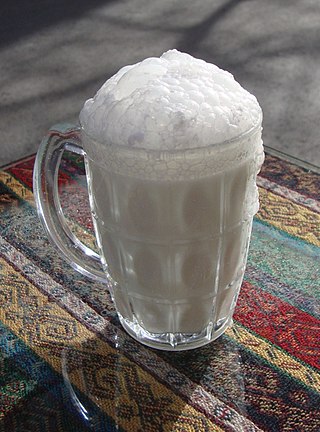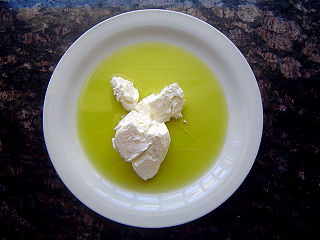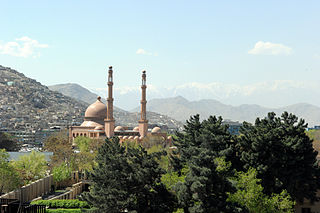
Turkish cuisine is the cuisine of Turkey and the Turkish diaspora. Although the cuisine took its current rich form after numerous cultural interactions throughout centuries, it should not be confused with other cuisines such as Ottoman cuisine or Seljuk cuisine. Turkish cuisine with traditional Turkic elements such as yogurt, ayran, kaymak, exerts and gains influences to and from Mediterranean, Balkan, Middle Eastern, Central Asian and Eastern European cuisines.

Tzatziki, also known as cacık or tarator, is a class of dip, soup, or sauce found in the cuisines of Southeastern Europe and West Asia. It is made of salted strained yogurt or diluted yogurt mixed with cucumbers, garlic, salt, olive oil, red wine vinegar, sometimes with lemon juice, and herbs such as dill, mint, parsley and thyme. It is served as a cold appetiser (meze), a side dish, and as a sauce for souvlaki and gyros sandwiches and other foods.

Yogurt is a food produced by bacterial fermentation of milk. Fermentation of sugars in the milk by these bacteria produces lactic acid, which acts on milk protein to give yogurt its texture and characteristic tart flavor. Cow's milk is most commonly used to make yogurt. Milk from water buffalo, goats, ewes, mares, camels, and yaks is also used to produce yogurt. The milk used may be homogenized or not. It may be pasteurized or raw. Each type of milk produces substantially different results.
Doogh is a cold and savoury drink made with fermented milk. Unlike its sister beverage of Turkish origin, Ayran, Doogh is not simply diluted yogurt. According to the Ministry of Food Standards in Iran, Doogh "is a drink resulting from lactic fermentation of milk whose dry matter is standardized by diluting yogurt or buttermilk ." The manufacturing process of Doogh involves a sometimes lengthy period of fermentation in warm temperatures, which comes to be the ultimate cause behind this drink's savoury taste.

Jameed is a Middle Eastern food consisting of hard, dry yogurt made from ewe or goat's milk. Milk is kept in a fine-woven cheesecloth to make a thick yogurt. Salt is added daily to thicken the yogurt even more and the outside of the yogurt-filled cheesecloth is rinsed with water to allow any remaining whey to seep through. After a few days of salting the yogurt, it becomes very dense and can be removed from the cheesecloth and shaped into round balls. It is then set to dry for a few days. If it is dried in the sun it becomes yellow; if it is dried in the shade it remains white. It is important that the Jameed is dry to the core because any dampness can spoil the preservation process. Jameed is the primary ingredient used to make Mansaf, the national dish of Jordan.

Iraqi cuisine is a Middle Eastern cuisine that has its origins in the ancient Near East culture of the fertile crescent. Tablets found in ancient ruins in Iraq show recipes prepared in the temples during religious festivals—the first cookbooks in the world. Ancient Mesopotamia was home to a sophisticated and highly advanced civilization, in all fields of knowledge, including the culinary arts.

Ayran, dhallë, dew, avamast, mastaw, shaneena, or xynogala is a cold savory yogurt-based beverage popular across Central Asia, West Asia, Southeastern Europe, South Asia, North Asia and Eastern Europe. The principal ingredients are yogurt, water and salt. Herbs such as mint may be optionally added. Some varieties are carbonated.

Mattha is a beverage that originates from the Indian subcontinent. It is made from dahi (yogurt) or buttermilk mixed with spices and sugar. Plain buttermilk is also called Mattha in the Indian states of Bihar, Tripura, Uttar Pradesh, West Bengal and Bangladesh Ingredients added to buttermilk to make mattha may include mint, roasted cumin seeds, asafoetida, curry leaves, salt and sugar.

Kashk, qurut, chortan, or aaruul and khuruud is a range of dairy products popular in Middle Eastern cuisine, Caucasian cuisine, and Central Asian cuisine. Kashk is made from strained yogurt, drained buttermilk or drained sour milk by shaping it and letting it dry. It can be made in a variety of forms, like rolled into balls, sliced into strips, and formed into chunks.
Armenian cuisine includes the foods and cooking techniques of the Armenian people and traditional Armenian foods and drinks. The cuisine reflects the history and geography where Armenians have lived and where Armenian empires existed. The cuisine also reflects the traditional crops and animals grown and raised in Armenian-populated or controlled areas.

Strained yogurt, Greek yogurt, yogurt cheese, sack yogurt or kerned yogurt is yogurt that has been strained to remove most of its whey, resulting in a thicker consistency than normal unstrained yogurt, while still preserving the distinctive sour taste of yogurt. Like many types, strained yogurt is often made from milk enriched by boiling off some water content, or by adding extra butterfat and powdered milk. In Europe and North America, it is often made from low-fat or fat-free cow's milk. In Iceland, a similar product named skyr is made.

Afghan cuisine is influenced to a certain extent by Persian, Central Asian and Indian cuisines due to Afghanistan's close proximity and cultural ties. The cuisine is halal and mainly based on mutton, beef, poultry and fish with rice and Afghan bread. Accompanying these are common vegetables and dairy products, such as milk, yogurt, and whey, and fresh and dried fruits such as apples, apricots, grapes, bananas, oranges, plums, pomegranates, sweet melons, and raisins. The diet of most Afghans revolves around rice-based dishes, while various forms of naan are consumed with most meals. Tea is generally consumed daily in large quantities, and is a major part of hospitality. The culinary specialties reflect the nation's ethnic and geographic diversity. The national dish of Afghanistan is Kabuli palaw, a rice dish cooked with raisins, carrots, nuts, and lamb or beef.
The cuisine of Kosovo is a representative of the cuisine of the Balkans and consists of traditional dishes by ethnic groups native to Kosovo. Due to ethnic connections with Albania, it has been significantly influenced by Albanian cuisine and has adopted elements of other Balkan countries.

The term Leben, variously laban, liben, lben in the Middle East and North Africa, refers to a food or beverage of fermented milk. Generally, there are two main products known as leben: The yogurt variant for the Levant region and the buttermilk variant for parts of Arabia and North Africa (Maghreb). Leben can be served at breakfast, lunch, or dinner.

Qatiq is a fermented milk product from the Turkic countries. It is considered a more solid form of yogurt than ayran.

Ash-e doogh is a yogurt soup found in various parts of Iran, Azerbaijan and Shiraz, with differing but similar ingredients. It is a kind of Aush. Similar dishes are found all over West Asia.

Curd, also mosaru or dahi or Thayir or Perugu, is a traditional yogurt or fermented milk product, originating from and popular throughout the Indian subcontinent. It is usually prepared from cow's milk, and sometimes buffalo milk or goat milk. The word curd is used in Indian English to refer to homemade yogurt, while the term yogurt refers to the pasteurized commercial variety known as heat-treated fermented milk.

Spas is a matzoon-based soup. It is a traditional dish in Armenia. Besides matzoon, the main ingredient are herbs, and hulled wheat berries.


























